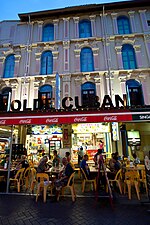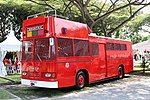Ya Kun Kaya Toast
Ya Kun Kaya Toast (simplified Chinese: 亚坤加椰面包; traditional Chinese: 亞坤加椰麵包; pinyin: Yà Kūn Jiā Yē Miànbāo), often colloquially known just as Ya Kun (simplified Chinese: 亚坤; traditional Chinese: 亞坤; pinyin: Yà Kūn), is a Singaporean chain of mass-market, retro-ambience cafés selling toast products (notably kaya toast), soft-boiled eggs and coffee. Founded by Loi Ah Koon in 1944, Ya Kun remained a small family-run stall for decades, but has expanded rapidly since Loi's youngest son headed the business in 1999. The chain has over fifty outlets, mostly franchised, across 14 countries, and is a Singaporean cultural icon, known for its traditional brand identity and conservative, people-centric corporate culture.
Excerpt from the Wikipedia article Ya Kun Kaya Toast (License: CC BY-SA 3.0, Authors).Ya Kun Kaya Toast
Tanglin Halt Road, Singapore
Geographical coordinates (GPS) Address Nearby Places Show on map
Geographical coordinates (GPS)
| Latitude | Longitude |
|---|---|
| N 1.3 ° | E 103.8 ° |
Address
New Town Primary School
Tanglin Halt Road 300
148812 Singapore
Singapore
Open on Google Maps







